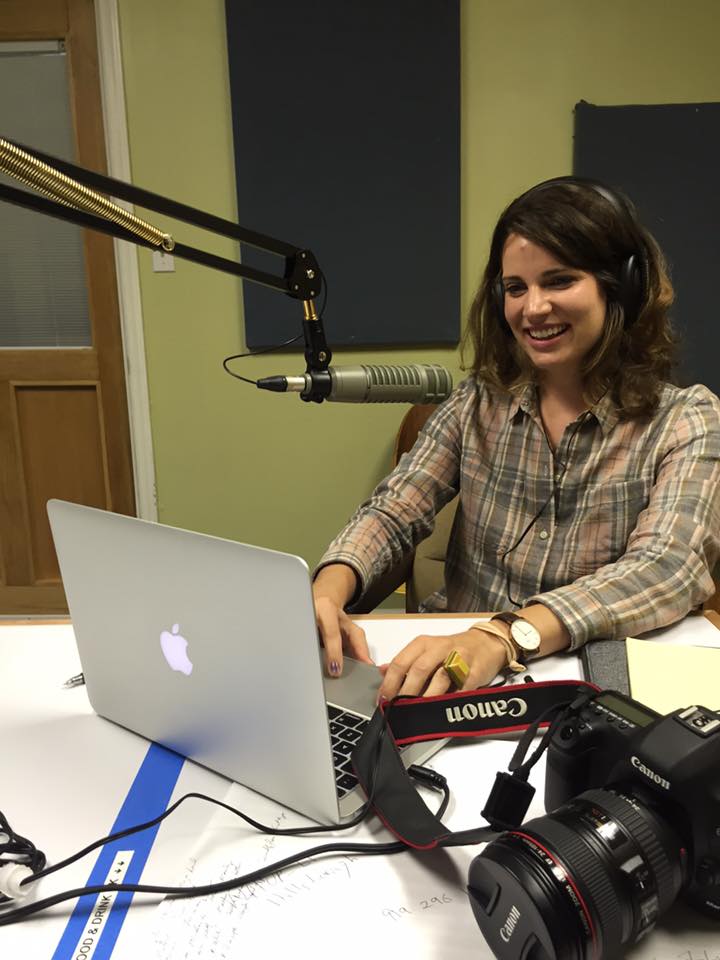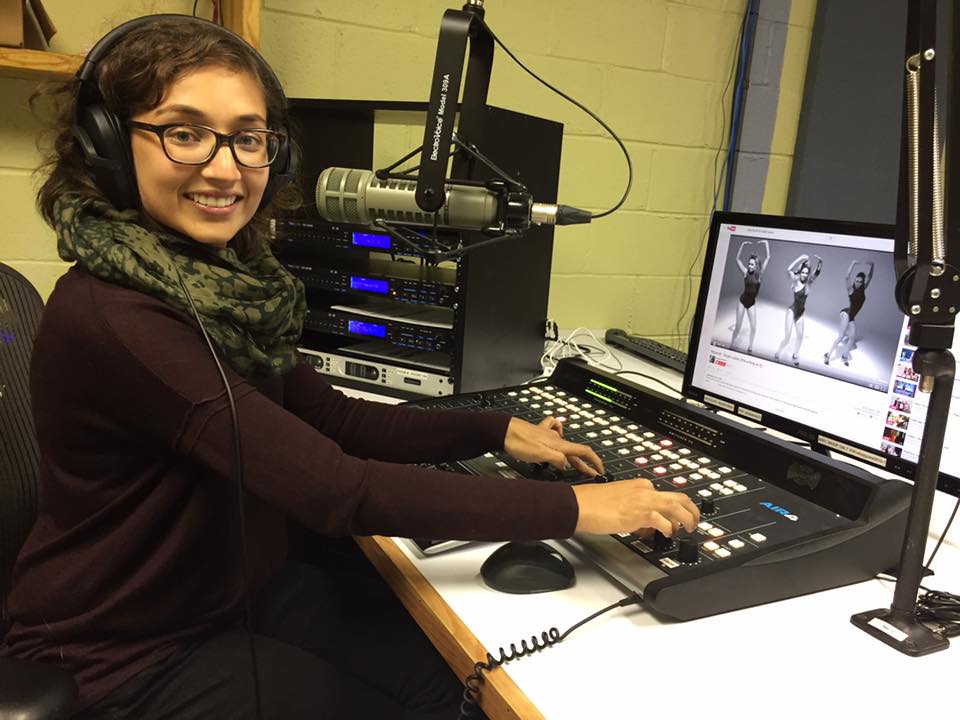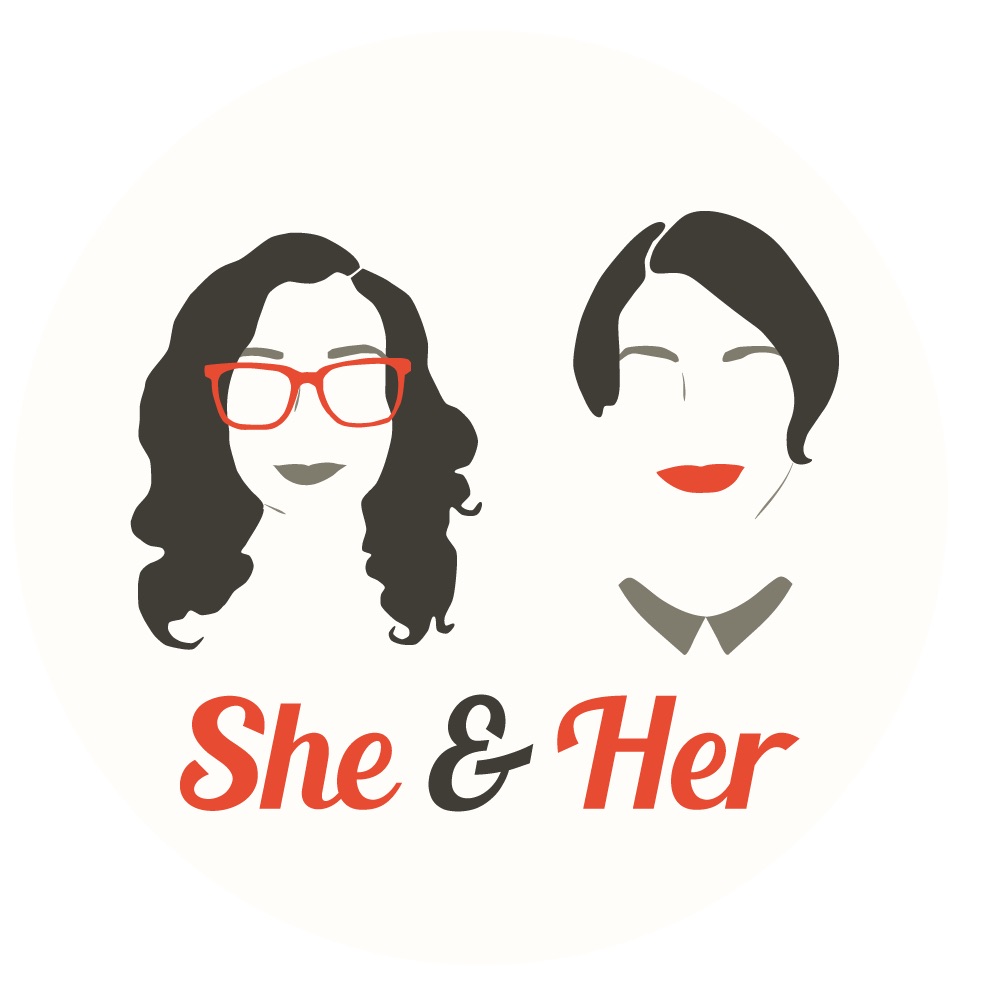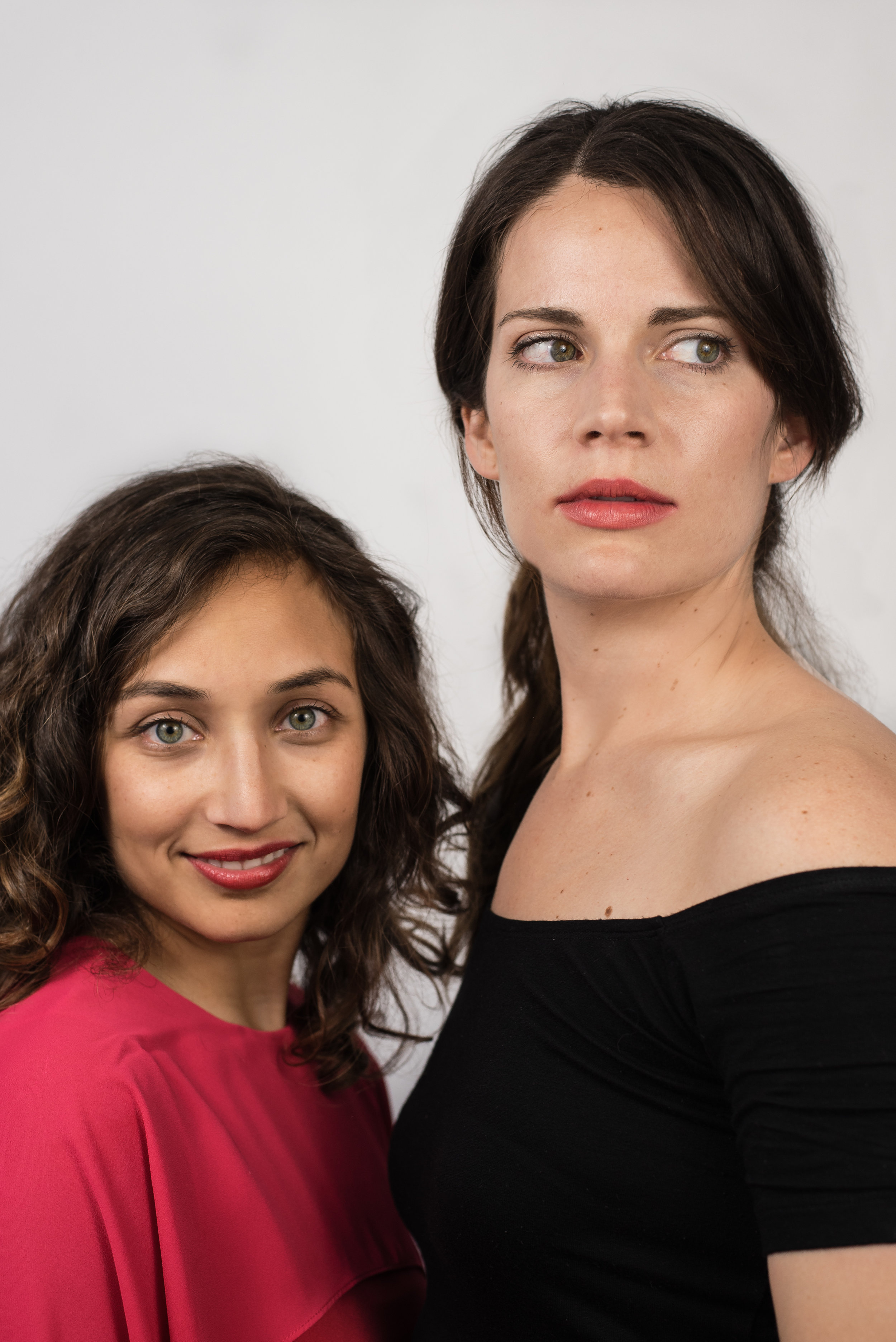by Kelly
One of my favorite parts of Anita and Sandra's feminist podcast is the conversations they have with their moms. The show is geared toward millennial women—most guests are in their 20s and 30s—but "The Moms" routinely chime in, offering perspective I always find comforting and refreshing. Whether the topic is identity, politics, or getting your first period, the Moms do not disappoint.
Anita and Sandra started their show, She and Her, nearly two years ago from their home base in North Carolina. Now, about 50 episodes in, the two women have covered an impressive range of subjects and hosted plenty of insightful, articulate guests. Episode by episode, the podcast unpacks multiple layers of "feminism with a southern spin." And yes, the occasional southern drawls are fantastic.
In our interview, Anita and Sandra are wonderfully generous in sharing their process and personal journeys. My only regret is that we didn't get to hear from the Moms—but maybe that's still in our future. We hope you enjoy this portrait of another unique and inspiring collaboration.
Where and when and how did your friendship begin?
Sandra: It was August, blazing hot and the beginning of a new semester. The air-conditioner roared as it pumped cold air into a institutional classroom... and I nervously scrawled “Women’s Studies” on the top of my blank notebook. In walked Anita…
All jokes aside, Anita and I met as juniors in a women's studies class at UNC-Chapel Hill. We became study buddies and the fastest of friends. It’s safe to say I’ve grown so much with her. I grew up with a creative, funny, resourceful, and independent group of girlfriends from rural NC who generally believed in equal rights for all, but didn’t have what I would call a “particular notion” of feminism. Myself included. I learned a lot about what feminism meant through Anita, and later through the loving and ambitious group of women she surrounded herself with in college. Our friendship’s given me a language to talk about my hopes, dreams, and struggles that both honors my very particular identity and experiences and helps me understand the forces that shape what’s possible for me and other women.
I learned a lot about what feminism meant through Anita... Our friendship has given me a language to talk about my hopes, dreams, and struggles.
Anita: Leave it to Sandra to have a flair for the dramatic! Haha. But yes! In a very fitting way it did begin in a Women’s Studies class, “Women and Islam in Africa,” to be exact. I remember Sandra always carrying a massive backpack filled with all the supplies necessary to maximize a day on campus, including a pair of running shoes and a ziplock bag filled with Coffee Mate powdered creamer. I also very clearly remember her baking cookies for the whole class on a day when we were set to watch a very dark documentary.
I think the first time we really hung out one-on-one was when we paired off to work on a class presentation, and Sandra’s quick mind and thoughtful insight were evident right away. It was also clear from the get-go that she brings a lot of warm and joyful energy to the environments that she is a part of, and I was really drawn to that!
How did decide to start She & Her together? Why?
Sandra: During the three to four years after college, we stayed in touch mostly over Gchat and were always musing and mulling about our experiences, and the stories we heard from our girlfriends, aka young women trying to make it in the world. We both went into the field of storytelling—Anita through StoryCorps and the State of Things—and I through freelance work as a documentarian and Bit & Grain, and we often talked about working together.
After several years of living in different parts of the country, we found ourselves back in North Carolina living in the same city. There’s such a strong storytelling community in the Triangle, and we heard through the grapevine that a brand new community radio station in Hillsborough was taking pitches for shows. So we did!
We found ourselves talking often about how we didn’t see many stories about women our age in the media. Sure, there was talk about "millennials," but much of it felt flat and one-dimensional.
Anita: We owe a lot of credit to Gchat for helping us get this thing started… that is true. As we both navigated post-college life in new and different environments, we found ourselves talking often about how we didn’t see many stories about women our age in the media we were reading. Sure, there was a lot of talk about “millennials,” but much of it felt flat and one-dimensional, and the stories that did exist rarely addressed millennial women and millennial feminism in particular. At the same time that we were having these observations, we had both fallen in love with audio storytelling, and podcasting as a platform, in particular.
So once Sandra heard about this new community radio station through the grapevine of her folklore contacts, she brought up the idea to me, and it seemed like a safe and fun environment to try to do something creative together! Our vision from the beginning was more or less to create a platform for women in their 20s and 30s to talk about their lives and work through the lens of what it means to be a woman in the world right now.
Our vision from the beginning was to create a platform for women in their 20s and 30s to talk about their lives and work through the lens of what it means to be a woman in the world right now.
What does your process of working together look like?
Anita: We have been at this for almost a year and a half now and tried out a number of different systems, but a lot of it boils down to a good mix of in-person chatting and brainstorming, constantly texting and e-mailing one another, tagging each other in Google Docs, and uploading a lot of audio to Dropbox! We’ve found that meeting in person every few months for a long brainstorm and editorial meeting sets the stage well for how our collaboration will unfold over the following weeks.
We gather at one of our houses, with our dogs in tow, and a sufficient supply of coffee, seltzer, or wine.
We gather at one of our houses, with our dogs in tow, and a sufficient supply of coffee, seltzer, or wine, and we start by thinking about what topics we would like to tackle. We try to let ourselves think big first before we get too bogged down in the particulars of, “Well who exactly do we know that could talk about that?” Then we divvy up the episodes we are working on so that one of us can serve as the point person for e-mails, phone calls, scheduling, and booking.
Once we have our guests booked, we brainstorm questions and draft scripts together through Google Docs… and then, for the most part, we record our episodes on Thursday evenings during our live slot at the community radio station in Hillsborough.
After our episodes are recorded, one of us takes the lead on editing, and then we upload an audio draft and send it to the other one for more editing and critique! Whoever is not working on the audio editing works on pulling together various materials to roll out the episode on our publishing platform, ACast, as well as on Facebook, Twitter, and Instagram. So all in all we try to divide things pretty equally, but one of us will step in to do more when the other is slammed with her “real job!”
Sandra: What she said. The only thing I’ll add is we’ve often revisited Beyonce’s Lemonade during our bigger editorial meetings for creative inspiration :-)
We’ve often revisited Beyonce’s Lemonade during our bigger editorial meetings for creative inspiration.
Do you each have different strengths or skills that complement each other in your work?
Anita: Certainly... I worked at StoryCorps in the production department, and now I’m a producer for a daily, live talk show, so I bring my experience editing audio, mixing music, and scripting for radio to the table. Sandra, on the other hand, has a lot of experience in film, photography, and narrative writing, so we have been able to support each other in expanding our different media skills, and I think we have been able to tag-team well because of that.
And then personality-wise I would say we are quite different! We both are hard workers and perfectionists in our own ways, but I am more likely to focus in on lots of the small details, while Sandra thinks about the bigger picture story or vision we are working toward, so I think those two things balance each other out well when we plan and envision our episodes. We also record most of our shows live, and I’d say that a good 80 percent of the time we encounter some new technical problem that causes things to go awry. Sandra is very good at maintaining calm energy while we solve problems, while I am maybe more quick to think about the worst-case scenario and assume that everything is about to go to hell!
Sandra is very good at maintaining calm energy while we solve problems, while I am maybe more quick to think about the worst-case scenario and assume that everything is about to go to hell!
Sandra: WELL I’ve really had to cultivate that calmness. We’ve really had to work through our propensity to get tickled during particularly disastrous moments on live radio.
Our first couple of months featured a lot of hard cuts to music segments because we mispronounced something or really destroyed a transition and devolved into a solid 60 to 90 seconds of uncontrollable laughter. I remember one or two episodes where it was so bad that our moms (who usually listen live) started texting us, “Are you girls okay? What’s going on? Is the station having a problem?”
I will say that now we’ve gotten to a place where one of us is usually able to rescue the moment... and I think that translates across our collaboration. I think we have a good sense when one or the other needs to “rise to the occasion.”
I remember one or two episodes where it was so bad that our moms (who usually listen live) started texting us, "Are you girls okay? What’s going on? Is the station having a problem?"
Why collaborate? What do you gain from your creative partnership?
Sandra: I typically would much rather be in conversation about my work than in a vacuum with it. It’s so much fun and so very meaningful to dream up ideas together and collectively own them - even when we divide and conquer certain tasks. There’s an editorial component of collaboration that can really strengthen an end result, and then there’s the artistic component of a collaboration that allows the two of us to really get to the heart of a story and show.
I would much rather be in conversation about my work than in a vacuum with it.
Anita: I have worked in a team environment for most of my professional creative work, and I find it to be very enriching and fulfilling. Everyone needs an editor, and an extra set of ears and eyes to make their work better, so I think working together first and foremost makes the content that we put out there more editorially sound and artful. I also think that because this is a “passion project,” aka something we do in addition to our day jobs, it is especially important to be working in partnership with someone else.
We hold each other accountable to keep returning to the mission of why we are doing this in the first place, and it makes things more fun. Sometimes it’s just me at home by myself at night with a pair of headphones, but there is something about knowing that Sandra will be doing the same thing that next morning, and that I’m working to make something that we are both proud of, that I think really keeps me going. Our creative partnership fuels my passion for telling good stories, and for creating community around the work that we do.
How has your partnership helped to challenge or pushed your work?
Anita: Sandra and I were best friends before we started working on this project together, so I think this collaboration has challenged and pushed us in both our personal and creative work. We are in constant communication with one another about things related to She & Her, so the partnership has made us learn how to be more direct and intentional with how we express our needs to one another so that things don’t get in the way of our working relationship.
I think we are also learning that in order to have a working partnership, we have to be more intentional about setting aside time to hang out that has nothing to do with She & Her because it is important to both of us to keep our friendship healthy and strong. And of course, that in turn allows our creative partnership to flourish! Sandra is good about continuously encouraging us to try out new things, like hosting live events, giving presentations, and teaching classes… and that has been so good for the show!
So I think having one another, and knowing that at the end of the day we both have the other’s back, has allowed us to be more experimental and bold than each of us would be alone.
Sandra: I couldn’t agree more. Anita’s carefulness, attention to detail, and constant drive for diverse storytelling have really impacted my work outside She & Her.
To bring it all full circle, our friendship and working relationship continue to help me grow into a more thoughtful and intentional friend, person and storyteller. (LOVE YOU PEEP)
Anita Rao is a public radio producer who works to bring underrepresented voices and perspectives to the forefront. From 2011 - 2014, she worked for the Peabody Award-winning StoryCorps where she pitched, edited and produced conversations from across the nation. Since 2014 she has been producing for The State of Things, North Carolina Public Radio WUNC's flagship show that features the issues, personalities and places of North Carolina. She is now the managing editor and guest host for the show. She has received Gracie Awards from the Alliance for Women in Media for her commitment to producing content by, for, and about women. As the co-founder and co-host of She + Her, she continues her commitment to exploring how gender shapes the lives of diverse women-identified folks.
Sandra Davidson is an entrepreneur and folklorist devoted to telling hard hitting stories about culture, politics and social justice. Her photography, writing, videography and podcasts are featured regularly on Bit & Grain, a digital publication about North Carolina that she cofounded in March 2015. Since March, Bit & Grain has been featured in the Columbia Journalism Review, the International Journalist's Network and The New York Times. She also co-founded, hosts and produces the radio show and podcast She + Her through which she continues her commitment to bringing diverse, intergenerational conversations to the public.




